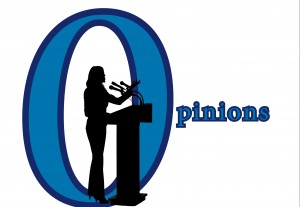Art for art’s sake. This is the translation of the Latin phrase ars gratia artis, which serves as the motto for MGM Movie Studios. This phrase is incredibly important as it inspires artists to create for the inherent value of art, without a need for social acceptance, cultural significance- or money. Recently, street artists like the famous Banksy have been creating art in this tradition on public spaces across the globe. Artists have even carried this tradition to campus, as was seen at the lacrosse stadium with an interactive art piece asking students to write their favorite poem in chalk on the walls of the walkway. The art created by Banksy and students was not tolerated by authorities, and has been interrupted or removed. If authorities want to limit where art can be created, fine, but there should be places on campus and around cities where the public is free to create art at will.
During his month-long residence in New York City, Banksy revealed a new piece of art each day. From his famous street paintings to sculptures and films, Banksy’s art was intended to be viewed by the masses. This attitude towards popular art is admirable, as art has traditionally been an experience reserved for the privileged. Banksy and street artists like him create their graffiti not to deface buildings, but to provide art that is readily available to the public. On Oct. 23, though, Banksy posted a message to his website reading: “Today’s art has been cancelled due to police activity”. This is part of a larger pattern, with Mayor Bloomberg and the NYPD expressing an interest in stopping Banksy from creating his street art. While I understand the need for order and public spaces free from damage, there is no reason that an entire genre of artwork like Banksy’s should be outlawed. It would improve cityscapes to designate certain public areas to be used for public art, with anyone able to come and create art for the world to see.
The same goes for DU. The interactive poetry mural on the lacrosse walkway not only strengthened a sense of community, but it also created a rare outlet for people to express their favorite poems or write their own work. The chalk on the wall hurt nobody, so why wasn’t it allowed to stay up? To me, at least, this type of interactive art makes our campus unique and all the more beautiful. In fact, one of my favorite parts of my experience at Tennessee’s Bonnaroo Music and Arts Festival this summer was the amount of public art. From the interactive chalkboard with lines for people to write what they want to do before they died, to the hundreds of yards long wall decorated with festival-goers own spray paint creations, Bonnaroo provided plenty of places where fans could create and admire art. There’s no reason that we can’t have these same experiences on campus or in cities.
One issue that arises with a proliferation of street art is vandalism. In a space made for unfettered art, though, there is no such thing. If all art is acceptable, then no art in this space is beyond the pale. A public space for art would actually decrease graffiti, as street artists will gain a place where they can express themselves freely. Offensive art should also not be an issue. Most art that is considered offensive is deemed so because of sexuality or political expression, which should not actually offend anyone. While I can’t point out a specific area of campus or the city that can be made into a public art space, there is no reason not to experiment with permissible public art.










